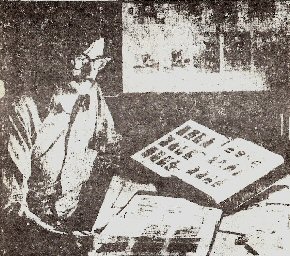The article represents a perspective of the vintage hobby from nearly forty years ago, written by someone outside the hobby.
| |

Egan with 30,000 card vintage collection |
While the hot stove baseball scene is getting warmed up by off-season trading among the big league baseball clubs, there's another big league operation that's also in full swing--swapping among baseball trading card collectors.
And if you think collecting baseball cards is for the small fry only, you've struck out. Richard Egan will thumb you out for that kind of thinking.
Egan is a 32-year-old chemist who lives at 108 N. Shaddle Av., Mundelein, and he freely admits collecting baseball cards "has gotten to be a disease" with him.
"I MUST have 30,000 cards, all carefully filed or cataloged. I trade, buy, or sell cards to improve my collection. I guess I have a collector's personality--we have to collect something."
Egan said he's not a professional dealer. He buys, sells, or trades only so he can improve his growing collection. He refuses to put a monetary value on the collection, tho he admits it is insured.
Tho his collection appears formidable, Egan figures that more than 100,000 different baseball card set have been printed in their history which goes back to 1886, when the Old Judge Cigarette Company issued cards featuring the players of the St. Louis Browns, New York Metropolitans, and others.
EGAN FIGURES that his most valuable set of cards [he prefers complete sets for his collection] is the one issued in 1910 by the American Caramel Company. It is a set of nearly 200 cards showing players of both leagues. He thinks he may have the only complete set of this issue.
But Egan is not alone in this field in the Chicago area. There are Richard Boe, Libertyville, a La Salle Street stock broker; Don Steinback, Romeoville, a bank accountant; William Loughman, Elmhurst, an airline pilot; and James Rowe Harvey, a tool and die manufacturing official.
They compose the Chicagoland Collectors Association of baseball card collectors. They, and some other who dabble in the hobby, will stage a 1974 Baseball Nostalgia Expo in September next year in the Sheraton-O'Hare Motor Hotel, Rosemont.
WHEN BASEBALL card collectors get together, there arise tales about THE baseball card--the fabled Honus Wagner card of which there are only 12 known to exist and which have sold for $1,000 or more at auction.
The cards were published in 1910 as a selling incentive for a tobacco company. But the great Pittsburgh Pirates shortstop was aghast that his name was tied to tobacco. Besides, he wasn't consulted or even paid for the use of this name and pictures, so he threatened suit. the printing was stopped short, tho some did go into general circulation.
Most cards, Egan explained, are valued from a quarter up to a couple of dollars, depending on rarity and age. Cards have been issued with products ranging from smoking tobacco, breakfast cereals, candy, and the now popular commodity, bubble gum.
ABOUT 60 years ago, the Cracker Jack company offered a set of 176 cards for only a dime. Today one of those cards commands a much higher price, wrote Charles [Buck] Barker in the association's convention program earlier this year.
Bubble gum trading cards were enshrined in the Baseball Hall of Fame, Cooperstown, N. Y., when the entire collection of 1971 Topps Baseball Cards were put on display there.
About 250 million of the pasteboards are printed annually. That's a lot of cards. But there are millions of kids who collect them each year, along with an estimated 50,000 adults, like Egan and his friends, who work hard keeping up with the hobby.
Hobby pioneer Richard Egan, the subject of the above article, wrote early hobby guides, especially on pre-1930 Candy and Gum ("E") cards. Soon after the newspaper article appeared, Egan contributed a 45-page section on E-Card sets that was printed in the first edition (1975) of the 

 OC eNewsletter Sponsor
OC eNewsletter Sponsor